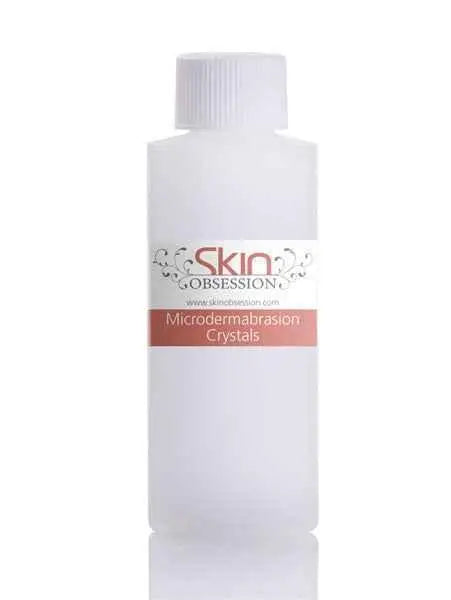My Store
Exfoliate with Our 8oz Microdermabrasion Crystals
Exfoliate with Our 8oz Microdermabrasion Crystals
Couldn't load pickup availability
Exfoliate With our 8oz Microdermabrasion Crystals
Everyone has heard of Exfoliation with Microdermabrasion crystal treatment to achieve smooth skin perfectly prepped for active ingredients to absorb evenly and fully for optimal results. Exfoliate With our 8oz Microdermabrasion Crystal rseveal your skin's natural radiance—a professional-grade exfoliant that gently buffs away dead skin cells and surface impurities. The fine crystal formula polishes skin to a luminous smoothness, creating the ideal canvas for serums and treatments to penetrate deeply and work their magic. Perfect for weekly refinement, this powerhouse polish transforms dull, congested skin into a glowing, receptive complexion ready to absorb every active ingredient in your routine.
Microdermabrasion crystal treatments and how they help remove that Dry, dull, and uneven skin can make your daily skincare routine feel like a constant battle. When dead skin cells build up, your complexion loses its natural glow, pores get clogged, and fine lines become more noticeable. This not only affects how your skin looks but also how your moisturizers and serums absorb, leaving you frustrated with lackluster results.
These skin concerns impact your confidence and can slow down your beauty regimen since you may feel the need for more products or treatments that don’t deliver. Without effective exfoliation, your skin’s texture feels rough and tired, making it difficult to achieve that smooth, radiant look you desire. These Microdermabrasion crystals will deliver on all levels!
Introducing the perfect solution: our 8 oz Microdermabrasion Crystals designed to exfoliate scrub your way to brighter, healthier skin. These aluminum oxide crystals gently yet effectively slough away dead skin cells, revealing a softer, more rejuvenated complexion that looks and feels incredible.
- Expertly formulated for all-over body use to smooth and refine skin texture
- Finely milled crystals that polish the skin without irritation, safe for regular exfoliation
- Promotes healthy cell turnover while enhancing absorption of your favorite moisturizers and treatments
Customers rave about how quickly these exfoliate scrub crystals transform their skin. One user shared, “After just a few uses, my skin felt unbelievably smooth and looked noticeably brighter. It’s now a vital step in my skincare routine.”
Take control of your skincare and experience the transformative effects of regular exfoliation with our 8 oz Microdermabrasion Crystals. Elevate your self-care ritual and enjoy the benefits of a radiant, glowing complexion every day—shop now and reveal your skin’s natural brilliance!
Transform Your Skin with Effective Exfoliation
Exfoliate with our 8oz Microdermabrasion Crystals to reveal smoother, healthier skin. These high-quality crystals gently remove dead skin cells, allowing fresh skin to emerge. Regular use can help to minimize the appearance of fine lines and improve the overall texture of your skin. It's easy to integrate this exfoliation product into your skincare routine because it requires only a small amount for each application, making it both effective and economical.
Enhanced Radiance and Clarity
Using our microdermabrasion crystals can help enhance the natural radiance of your skin. As you exfoliate, the crystals work to dislodge impurities and unclog pores, which in turn enhances the clarity of your complexion. However, be cautious and only exfoliate a few times a week to avoid irritation. Therefore, consistent use can lead to skin that looks bright and feels rejuvenated. You’ll notice that your skin care products absorb better and your makeup goes on smoother.
Easy Application and Results
To incorporate our 8oz Microdermabrasion Crystals into your routine, simply mix with your favorite cleanser or use it as a stand-alone treatment. Because they are finely textured, they provide a gentle yet effective exfoliating experience without harsh scrubbing. Many users report softer skin immediately after application, and with regular use, the results only get better. So, if you’re looking for fast and visible improvements, these crystals should be your go-to choice for skincare.
Why Choose Microdermabrasion Crystals?
Exfoliate with our 8oz microdermabrasion crystals for an effective way to rejuvenate your skin. These crystals work by buffing away dead skin cells, revealing a smoother and more radiant complexion. Unlike traditional scrubs, our crystals are designed to penetrate deeply, so they provide a thorough exfoliation experience without being too harsh. Moreover, they are suitable for various skin types, ensuring everyone can benefit from their use.
How to Use Microdermabrasion Crystals?
Using our microdermabrasion crystals is as simple as it gets. Start by wetting your face and taking a small amount of crystals in your palm. Gently massage them onto your skin in circular motions for about 1-2 minutes, focusing on areas that require extra attention. Afterward, rinse thoroughly with warm water. It's important to exfoliate regularly, but not more than twice a week, to maintain healthy skin without overdoing it.
Benefits of Regular Exfoliation
Regular exfoliation with our crystals can lead to numerous skin benefits. It helps to unclog pores, minimize breakouts, and promote an even skin tone. Consequently, you will notice a reduction in the appearance of fine lines and blemishes. Therefore, investing in quality exfoliation like our 8oz microdermabrasion crystals can transform your skincare routine and contribute to long-lasting radiance.
INGREDIENTS
Share


